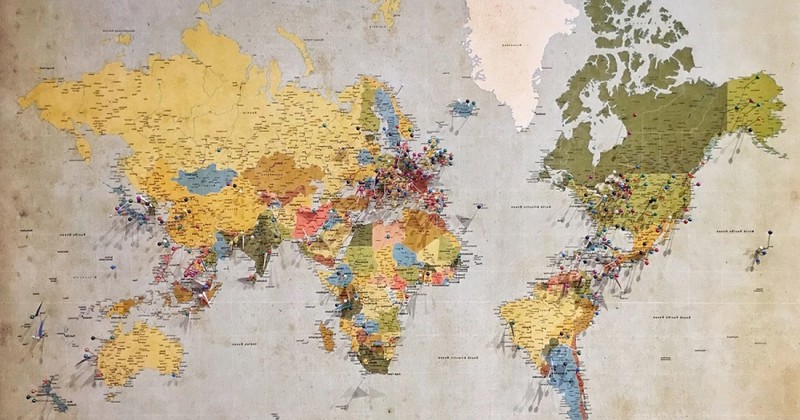The 8 main types of maps, and their characteristics.

A review of the main types of maps, from the political map to the topological map.
The different types of maps that exist The different types of maps that exist reflect the complexity of the territorial organization of human beings and of the regions we inhabit. These cartography-related elements can take the most unexpected forms, depending on the criteria used to design them.
In the following lines we will see a summary of the different types of maps, going beyond the simple classification that distinguishes between the electronic map and the physical map.
The main types of maps (and what each one shows us).
Here is a classification of the most popular types of maps.
1. Political map
This is one of the types of map in which physical elements are not represented, but rather only political territories and their boundaries appear: the borders .. In them appear states or regions with a certain sovereignty and self-government. Regardless of the scale of what is to be represented, be it a county or a supra-state organization, emphasis is placed on the notions of "inside" and "outside".
In cases where there is a territorial conflict that creates discrepancies between many parties involved, the borders come to be represented with broken lines, a representation resource that is often also used to mark the borders of a country's territorial waters.
Of course, as a political map is mainly a theoretical construct, in order to make one it is necessary that there be a certain consensus on the limits of a country's territorial waters. certain consensus on the limits of each political entity represented..
2. Geographic map
Being probably one of the most widely used types of maps, it attempts to give the information considered most relevant in most cases with regard to the physical elements. information considered most relevant in most cases regarding the physical elements of a territory, including scale representations of natural or human-made surfaces. of a territory, including scale representations of natural or human-made surfaces.
Normally, what is seen in one of these maps is what would be seen from a zenithal perspective if we were to adopt a perspective of the space by viewing it from a very high point. We try to achieve a good level of realism.
On the other hand, the size of what you want to represent can vary a lot, ranging from the entire surface of the earth to the entire surface of the earth. from the entire land area to the area occupied by a single municipality..
3. Topographic map
This type of map is characterized by highlighting the differences in height (expressed in contour lines) and, in general, the relief of the earth's surface. the relief of the terrestrial surface. It is also common to use coloring patterns to mark the space occupied by different types of geographical features.
4. Geological map
This type of map can be similar to the topological one, since it represents natural elements, but in this case less emphasis is placed on the relief and the shape of the earth's surface, and more emphasis is placed on the type of minerals that make up the terrain. The latter is often expressed using icons as symbolism for the different minerals and natural formations such as springs, volcanoes, volcanoes, volcanoes, volcanoes, volcanos, etc. such as springs, volcanoes, special mineral veins, and the like.
Thus, the variations of the territory that appear have to do with the characteristics of the distribution of minerals and the shape of the tectonic plates. In general, it is a matter of giving a picture of both what is on the surface and what is underground.
5. Climate map
In this case, the aim is to highlight the climatic differences between regions. This is done by coloring in a homogeneous way each zone sharing the same type of climate, sometimes creating overlapping zones (in which several colors are mixed using patterns of thin stripes).
6. Urban map
Urban maps emphasize the elements of urbanized areas, i.e., human-made constructions and communication routes for pedestrians and vehicles, to the point that in many cases nothing else appears, except for natural elements such as coasts and rivers.
Thus, they usually depict only the space occupied by a city, district the space occupied by a city, district or neighborhood, all to scale.all to scale. The type of graphic elements used for this purpose are usually simple and minimalist in style, in most cases using only polygons.
Sometimes color changes are used to indicate the presence of different types of spaces: old town, parks, beaches, etc.
7. Transit map
This is a variation of the urban map in which the layout of a city's public transport routes is almost exclusively represented, in a very simplified manner. The routes of buses, trains, subway networks, and streetcars are depicted with colored lines are represented with colored lines, and stations are marked for the main means of transport.
8. Weather map
This is the support used to show what are or will be the meteorological phenomena in each region, being represented with symbols representing rain, storm, cloudy, etc. As a consequence, the representation of the territory is usually simplecreated only so that each region can be easily recognized without the need to include more information not related to meteorology, something that would visually saturate the image.
Bibliographical references:
- Cosgrove D. E. (ed.) (1999). Mappings. London: Reaktion Books.
- O'Connor, J.J. and E.F. Robertson (2002).The History of Cartography. St. Andrews: St. Andrews University.
(Updated at Apr 13 / 2024)